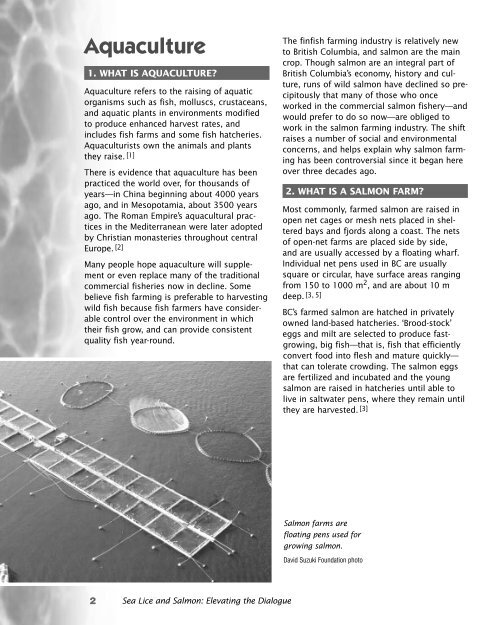Sea Lice AND Salmon - Farmed And Dangerous
Sea Lice AND Salmon - Farmed And Dangerous
Sea Lice AND Salmon - Farmed And Dangerous
You also want an ePaper? Increase the reach of your titles
YUMPU automatically turns print PDFs into web optimized ePapers that Google loves.
Aquaculture1. WHAT IS AQUACULTURE?Aquaculture refers to the raising of aquaticorganisms such as fish, molluscs, crustaceans,and aquatic plants in environments modifiedto produce enhanced harvest rates, andincludes fish farms and some fish hatcheries.Aquaculturists own the animals and plantsthey raise. [1]There is evidence that aquaculture has beenpracticed the world over, for thousands ofyears—in China beginning about 4000 yearsago, and in Mesopotamia, about 3500 yearsago. The Roman Empire’s aquacultural practicesin the Mediterranean were later adoptedby Christian monasteries throughout centralEurope. [2]Many people hope aquaculture will supplementor even replace many of the traditionalcommercial fisheries now in decline. Somebelieve fish farming is preferable to harvestingwild fish because fish farmers have considerablecontrol over the environment in whichtheir fish grow, and can provide consistentquality fish year-round.The finfish farming industry is relatively newto British Columbia, and salmon are the maincrop. Though salmon are an integral part ofBritish Columbia’s economy, history and culture,runs of wild salmon have declined so precipitouslythat many of those who onceworked in the commercial salmon fishery—andwould prefer to do so now—are obliged towork in the salmon farming industry. The shiftraises a number of social and environmentalconcerns, and helps explain why salmon farminghas been controversial since it began hereover three decades ago.2. WHAT IS A SALMON FARM?Most commonly, farmed salmon are raised inopen net cages or mesh nets placed in shelteredbays and fjords along a coast. The netsof open-net farms are placed side by side,and are usually accessed by a floating wharf.Individual net pens used in BC are usuallysquare or circular, have surface areas rangingfrom 150 to 1000 m 2 , and are about 10 mdeep. [3, 5]BC’s farmed salmon are hatched in privatelyowned land-based hatcheries. ‘Brood-stock’eggs and milt are selected to produce fastgrowing,big fish—that is, fish that efficientlyconvert food into flesh and mature quickly—that can tolerate crowding. The salmon eggsare fertilized and incubated and the youngsalmon are raised in hatcheries until able tolive in saltwater pens, where they remain untilthey are harvested. [3]<strong>Salmon</strong> farms arefloating pens used forgrowing salmon.David Suzuki Foundation photo2 <strong>Sea</strong> <strong>Lice</strong> and <strong>Salmon</strong>: Elevating the Dialogue
















